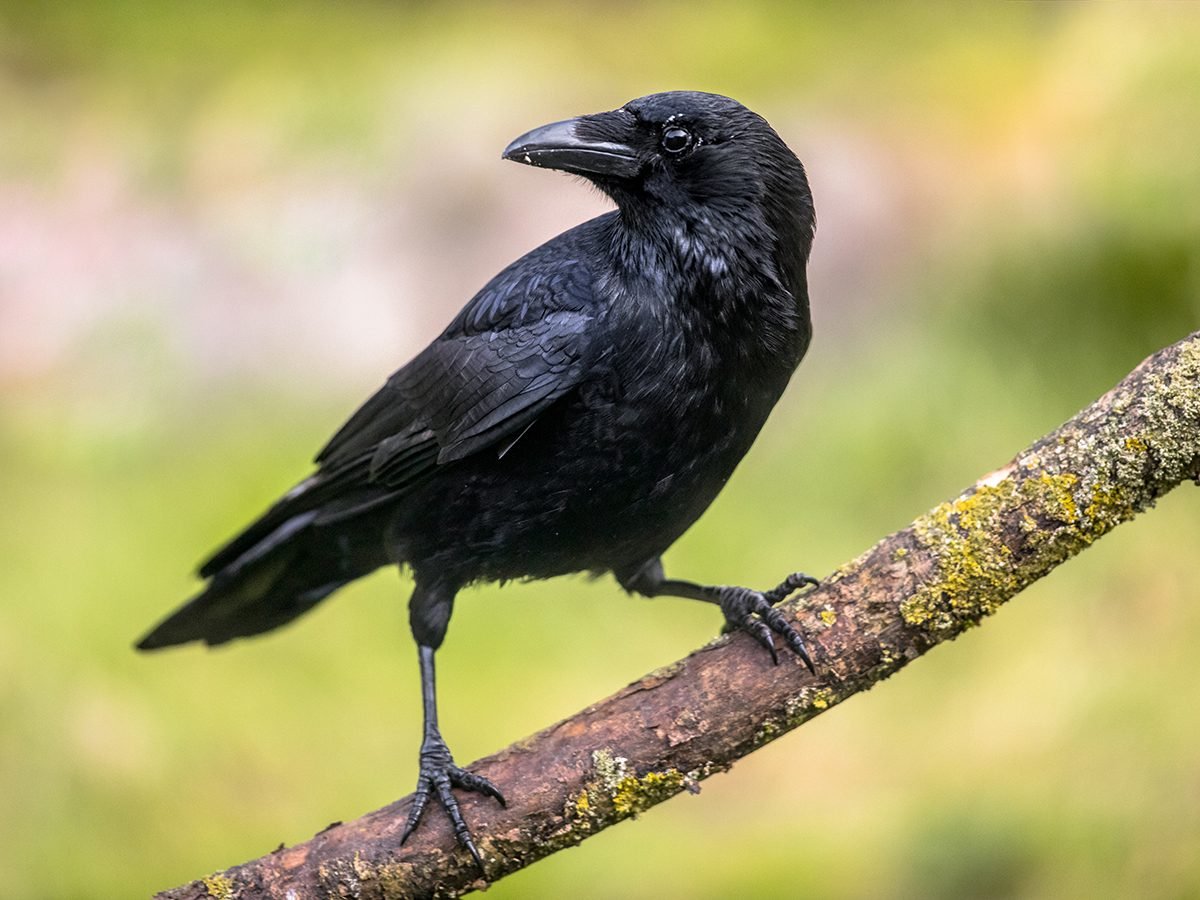
That Darned Crow
It was a hot day in June of 1968 when we got our first inkling that this summer was going to be different from previous ones.
Grandpa was working up on the farmhouse roof, loudly complaining about some darned crow dropping frogs down the chimney. Grandma came outside to watch. “I wondered what was putting the woodstove out! That darned crow!”
The “darned crow” landed on the roof and introduced himself, “CAW! CAW! CAW!” This was the start of our family’s love-hate relationship with a mischievous crow we called Fred.
We kids would be playing in the yard and Fred would be playing, too. He’d jump up and swing from the laundry Grandma had hung on the clothesline. He seemed very happy to grab onto a towel with his beak and swing back and forth. Grandma would shoo him away, but he’d soon be back, stealing clothespins off the line or swinging again. There would be laundry all over the lawn. We kids thought it was hilarious—Grandma, not so much.
Sometimes things weren’t so funny, though. We’d hear one of the girls screaming and immediately know it was because of Fred. The girl would be seen running down the path with Fred dive-bombing her. The grownups assured us that Fred only wanted our hat or hair clips, but it was scary imagining how he might one day land on someone’s head. We kids learned to keep an eye out for him.
Hair clips weren’t the only thing Fred wanted, however, he loved pop-bottle caps, jewelry and anything shiny. Everyone
learned to never leave anything we valued on the picnic table. We kids blamed the crow for everything that summer.
“I don’t know, Fred must have taken it,” was a familiar response. But I just know there’s a tree back in the woods crammed full of Fred’s treasures. My uncle treated Fred like one of our pets. He’d put the bird on his shoulder and walk into the house. Fred would look around at everyone with his beady black eyes and with a “CAW! CAW! CAW!” startle us all! Then someone brought the dog, the cat and even the pony into the house, too. We kids were so excited to have all these animals in the big front room. The fun was over though when Fred got too excited and left a surprise on the arm of my uncle’s shirt! “Everybody out!”
Fred flew away sometime that summer and never came back. The grownups said he most likely went off to start a family. Things got really quiet after that. We still got excited at any crow flying around, but always knew it wasn’t Fred. He would have swooped down for a visit and tried to steal something. That summer was more than 50 years ago, but I still call out to any crow I see, “Fred, is that you, Fred?” – Sandra Forsythe
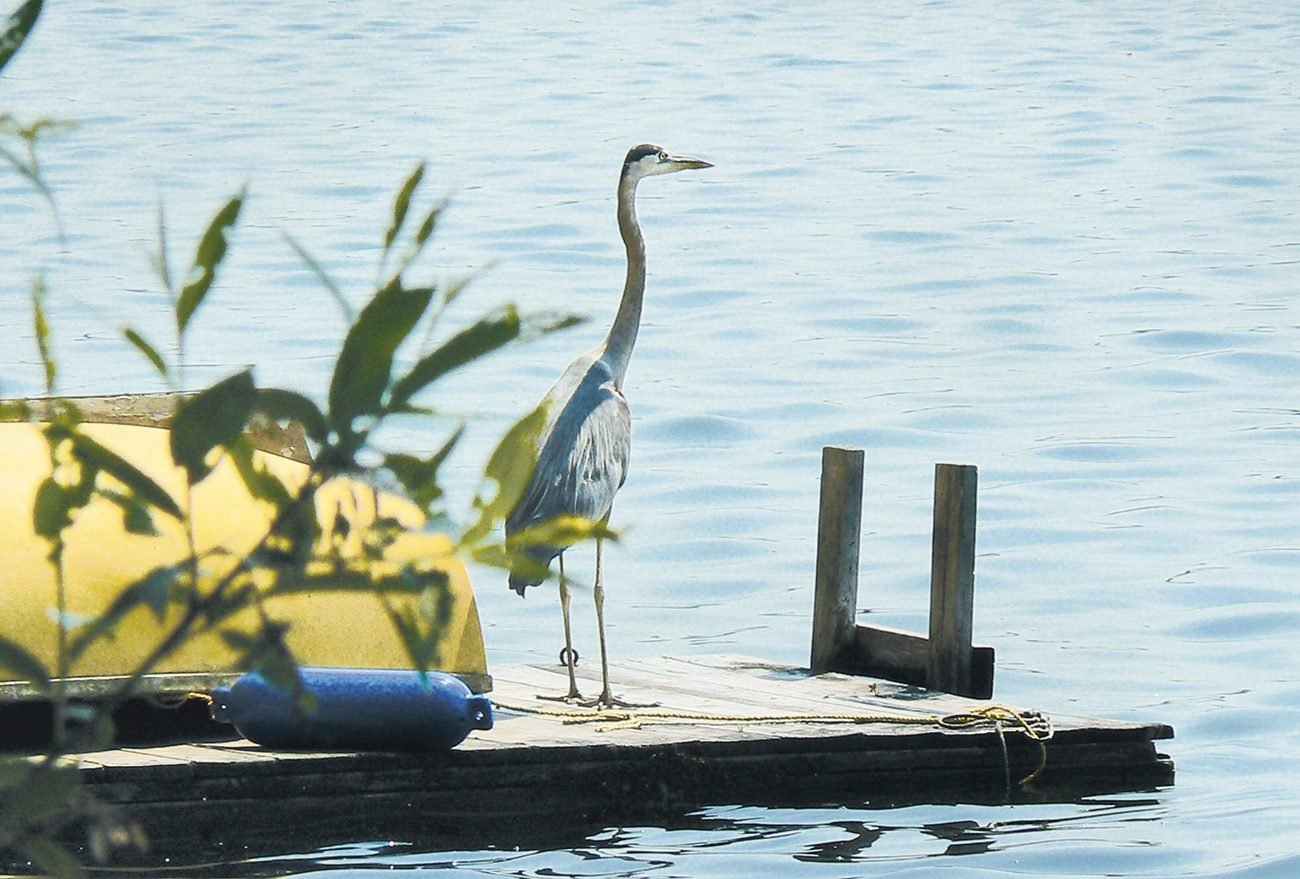
Quiet Elegance
The great blue heron is a familiar, anticipated visitor to the shores of rivers and lakes—particularly where there are marshy areas. This stately creature was fishing for breakfast off of our neighbour’s dock when we were living at our cottage on Three Mile Bay, White Lake, Ontario.
To begin my day watching this heron in its zen-like pose was a calming, peaceful introduction to the morning; as it was for most cottagers having the same experience along their part of the lakeshore.
The lake is rich with food and is a protected habitat making it a good place for blue herons to make their summertime
home. They look so graceful and focused as they patiently wait in perfect stillness for the small fish of the lake to swim in close enough to be caught. We called our daily visitor Ichabod, it just seemed like a fitting name for a heron.
Upon take-off, its large wing span made an unmistakable swooshing sound as the heron worked hard to rise up into the air and fly across the lake seeking a new spot in which to fish.
Spotting a great blue heron is a wonderful part of experiencing life on Canada’s lakes and rivers. To be able to quietly watch them engaged in their daily life enhances the pleasure and joy of our own lives. – Karen Hirst
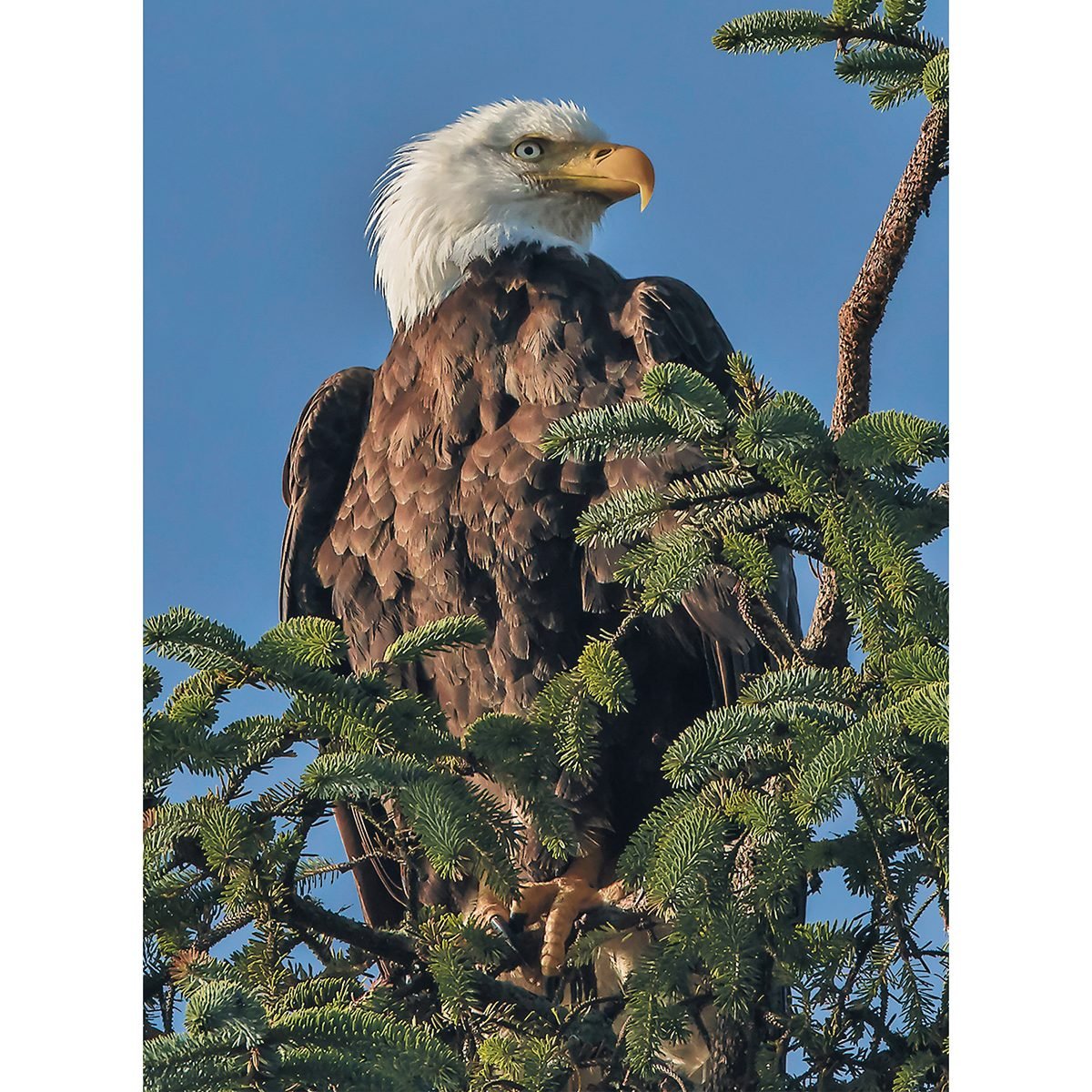
Perched On High
My favourite type of photography genres are nature and portraiture; for me, nature images are very similar to portraiture, especially street photography. The only difference with nature photos are that the subjects tend to have four legs, two wings or a tail! They rarely hold a pose when asked, or strike the particular pose requested by the photographer.
Although I cannot claim to be a “birder,” I do enjoy capturing pics of some types of birds, especially large ones such as bald eagles. They look so majestic, elegant and powerful—particularly in flight.
The bald eagle is not commonly seen here in Perth, Ontario, where I live, but is very common on Canada’s West Coast, where I love to travel. I spent some time in Masset and Old Masset in Haida Gwaii last summer. While there, I had ample opportunities to “shoot” some bald eagles, both adults and juveniles.
While driving along in Old Masset, I saw this bald eagle perched high in a Sitka spruce on the edge of the road. Of course I stopped my car, got out and started to take some pictures.
The eagle looked down at me as I looked up at it. I was hoping it would take flight but it didn’t. We watched each other for perhaps 20 minutes. I was using a teleconverter lens (used to magnify subjects) as I like my bird subjects to be up close and personal—as if I was shooting a portrait of a person. – Bruce Raby
Read how a mother-and-son tour of Haida Gwaii became the trip of a lifetime.
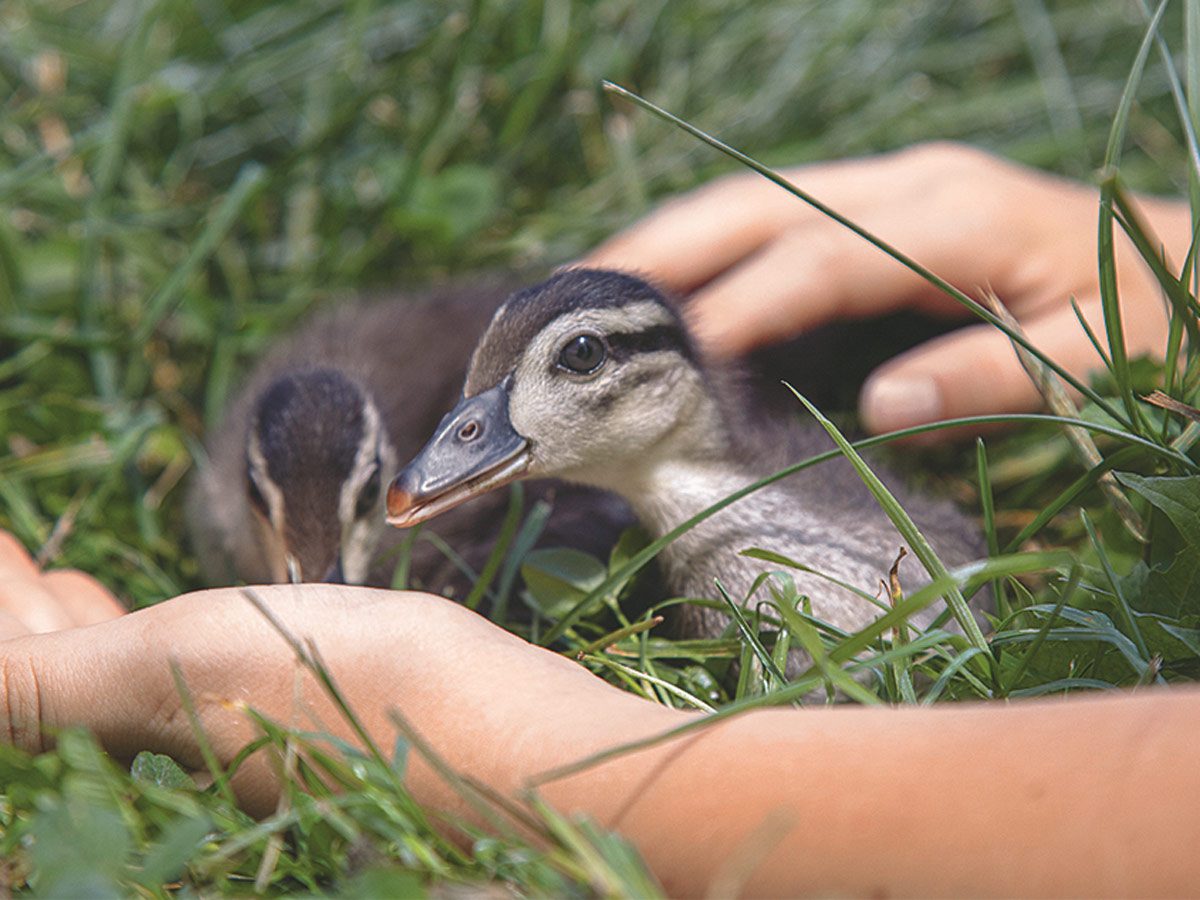
Just Ducky
Living in the rural Kawartha Lakes area, we see our fair share of wildlife and often find ourselves lending a hand when necessary. My husband and I help manage beaver populations along the railroad tracks, and during a long, wet walk into the bush one day, we came across three baby ducks that were stuck between the tracks.
Finding baby ducks along the railroad tracks is a common occurrence, as the mother duck can easily make her way up and over the tracks while the smaller ducklings are not as capable. We’ve often helped ducklings return to their mother but this time the mother duck was nowhere in sight. We decided to bring these little guys to our backyard pond, but needed to figure out how we were going to get them home.
With a truck full of supplies and little room to work with, the baby ducks got a cozy ride on the passenger seat in a large wooden box. Bringing the ducks home was exciting because we have four amazing children who take pride in tending to animals on our farm and it was no different with the baby ducks. The kids worked hard to gather materials to make a small shelter and filled it with leftover hay.
We named the ducks Huey, Dewey and Louie. Every morning, the kids would grind up corn in the blender and take it down to feed the trio. Soon the ducks were comfortable in their environment and began to venture out around the yard. We all enjoyed watching them waddle through the long grass, learning to catch bugs and other critters.
As they got larger, we were also able to watch them learn to fly across the pond. Finally one sunny afternoon, Huey, Dewey and Louie were ready to soar; we watched as they headed south in preparation for winter.
We’re all curious to see if they will make their way back to our pond in the future. —Sienna Frost
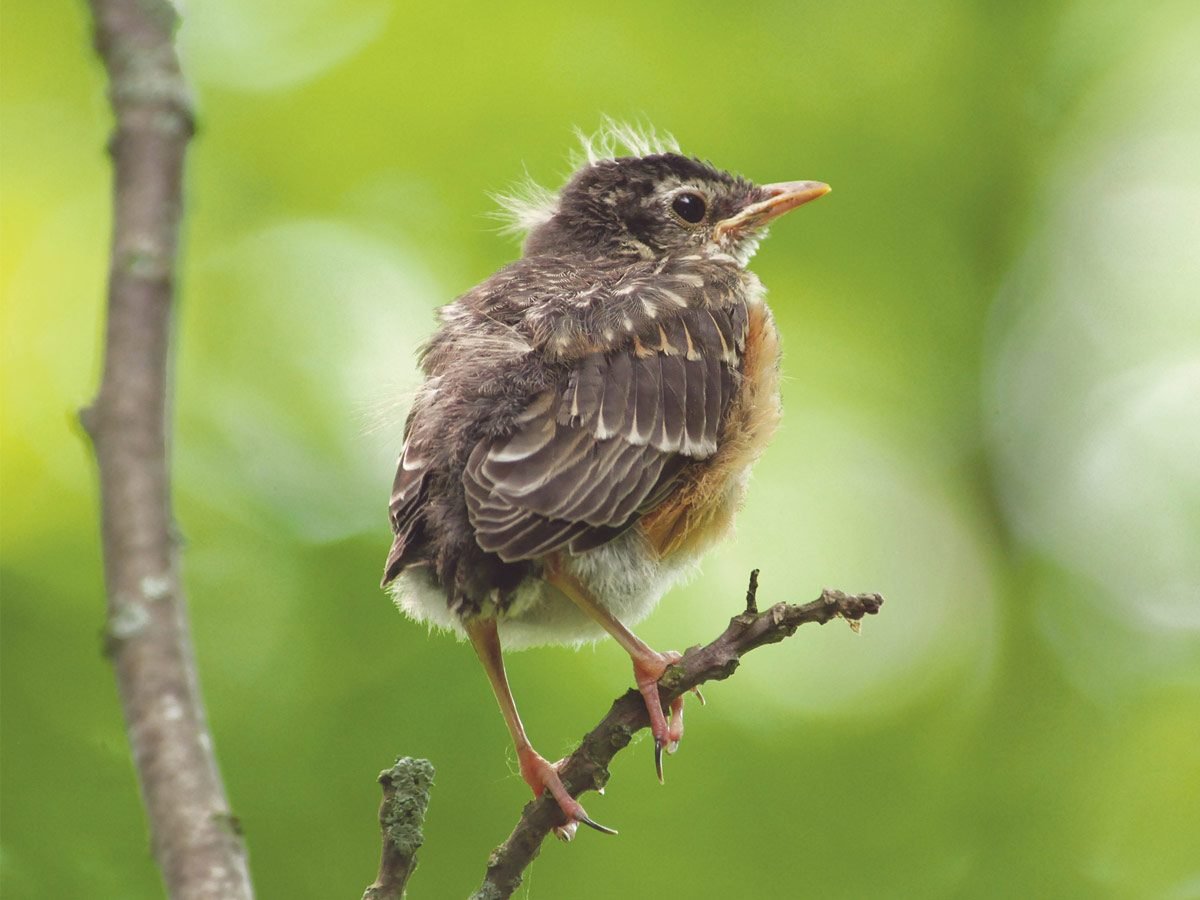
Spring to Life
Robins are among the hardest working of all the birds that flock to our garden in the spring. They are tireless in the pursuit of nourishment for their brood and they often raise three broods a summer! I love to listen to the sweet song of the male as he serenades his mate at dawn and again at dusk.
Try as I might, I often don’t get the thrill of seeing the juveniles after they leave the nest. They usually make the jump while I am at work and by the time I arrive home the nest is empty and the young ones are hiding in the shrubs, trees and perennials that fill our yard.
On this day, however, I was fortunate enough to notice a slight fluttering in the bottom of our very large spruce tree. I grabbed my camera and went to investigate. Hidden in the lower branches was this beautiful fledgling robin barely out of the nest. What a thrill. He posed nicely for a nanosecond and then hopped deeper into the tree. We planted our yard with wildlife in mind and it’s always exciting to witness the spring babies thriving. —Dayle Hayhoe
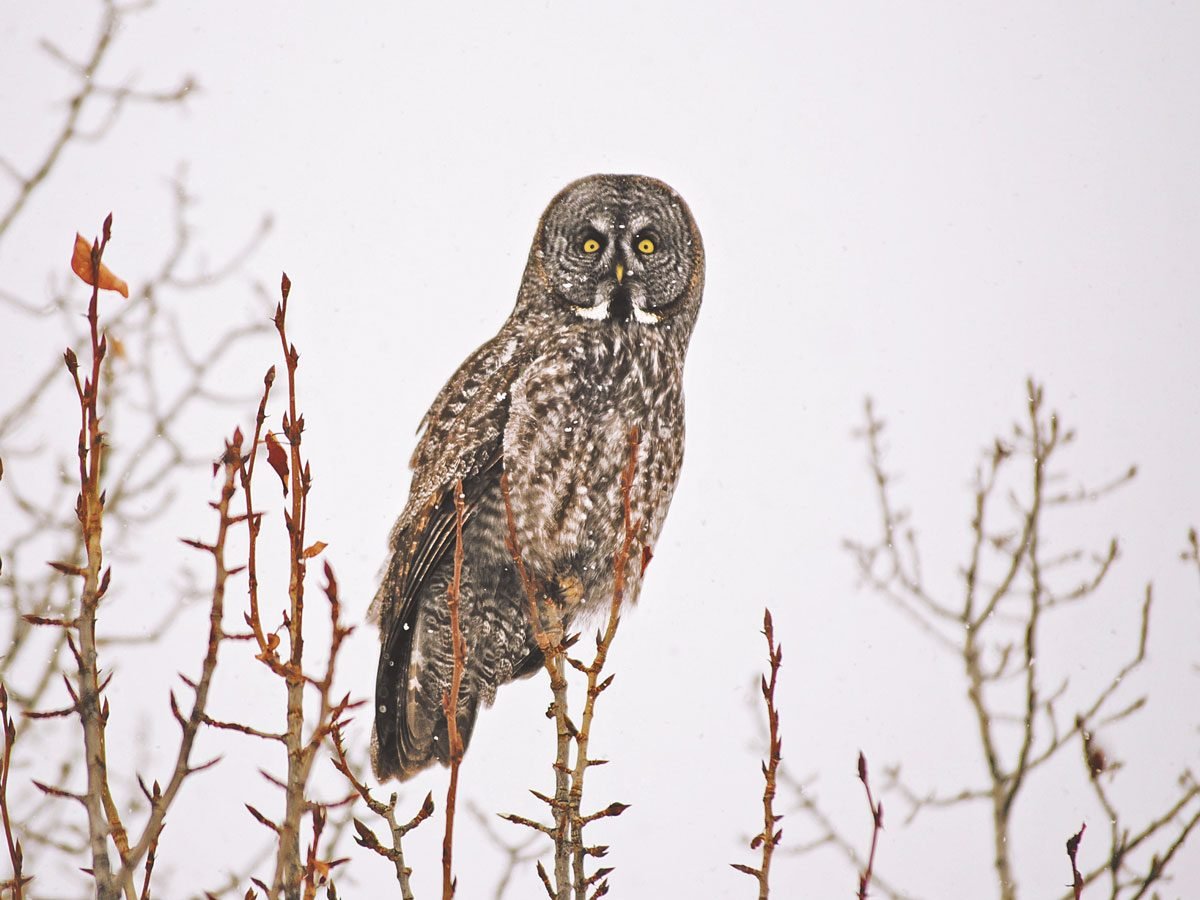
A Regal Encounter
After a quick glance in the rear-view mirror, I tap the brakes. My old farm truck fishtails through the slush. “Are you trying to kill us?” my 86-year-old mother shrieks. “No.” I grip the steering wheel, peer through the spring blizzard and stop as close to the edge of the road as I dare. I give Mother a huge smile. “I saw an owl.”
“You saw a what?”
“An owl. Back there, on a fence post.” I flick on the four-way flashers and reach behind the seat for my camera. “I’m sure it’s a great grey.”
“You saw a bloody owl? Are you crazy?” Mother shakes her finger at me. “We have to go home before the roads get worse.”
“I’ll be quick. I promise.” I flip the camera’s strap over my neck, get out and shut the door without making a noise. Large, fat flakes fall straight down. I tuck my camera inside my parka and support it with one hand as I skirt the truck to get to the snow-filled ditch. He’s still there. A grey blur. But even from a distance, and through the squall, his shape is unmistakable. It’s a great grey. Mother pounds on her window. I wave at her, tighten the tops of my mukluks and step onto the bank of snow. With one hand still supporting the camera, I stick my other arm out for balance. I take cautious steps, expecting each one to plunge me through a soft section but the snow holds. Flakes splat on my head. They soak my hair and chill my scalp.
When I get to the barbwire fence, I’m five fence posts away from the owl. I sneak my camera out. As I lift it, he turns his round head and faces me. Impassive. Regal. He stands on the post. He’s big, a metre tall at least. He leans forward. “No,” I whisper. His massive wings unfold and he takes off, slow, methodical flaps carry him across the snow-covered hayfield. He lifts, soars upwards and lands on top of a distant poplar tree.
“Damn.”
I stare at the distance between us. Two hundred metres? Maybe. I look down the fence line and see the weathered “No Trespassing” sign. I glance back to the owl. He’s still there. The sign is old and tattered. I turn to the truck. Mother watches me. “Five minutes.” I hold up five gloved fingers.
Before I take off, I check around to see if anyone else is watching. Maybe the No Trespassing sign is only a suggestion, meant for hunters, probably not owl watchers. I test the snow on my side of the fence. It’s solid. The wire squeaks when I press it down. Careful to avoid the barbs, I swing a leg over, set it down and tap the surface on the other side. It feels hard. Leaning down on the wire with one hand, I flip my other leg over. A scratching sound and the scraping sensation against the crotch of my jeans make me grateful for thick seams. With my next step, toward the owl, I sink to my knee. My balancing arm comes in handy as I flail it forward. The next five steps I stay on top of the snow. I get cocky right before my left leg disappears and I sink to my thigh. My spare arm’s windmilling motion stops me from doing a face-plant. I congratulate myself on staying upright, then check for the owl. Unfazed by my floundering, he’s still there. Not knowing when I’ll sink next, I prepare myself to limit any unnecessary body flailing. Grey owls are not afraid of anything, but I don’t want to annoy him. I move forward again. Some steps sink, others don’t.
When I’m within five metres of the tree, I take the lens cap off and zoom in. The owl turns his head to the distant woods. It’s a perfect profile shot. He looks at me. I take more pictures. I move closer to the tree. Close enough to see the large grey-and-brown concentric circle pattern around each bright yellow eye; similar to the growth rings of an ancient tree except these rings act as antennas and direct sound to the owl’s ears. I hold my breath as the camera clicks. The white bow-tie markings with a black centre, which are just below his yellowish beak and above the top of his neck, end the circular pattern around his eyes. Light greys and greyish browns dappled with dark grey cover the rest of his body. He turns his head to look behind himself, almost as if his head is not attached to his neck. When I have enough pictures, I put the lens cap on and tuck my camera back inside my coat.
I stare at the owl. His eyes lock on mine. I try not to blink until he does. It’s difficult. I can hear snowflakes land, there’s just me, the owl and the quiet. I watch him watch me. Moist air tickles my nostril. The finger-thick poplar branch he’s perched on is straight. Not the slightest bend. I’m afraid to move, not because I’m frightened of being hurt but because I feel movement would shatter this moment—this silent, perfect encounter. He tips his head at me. When a grey owl nods, it’s like he doesn’t have a neck. He nods again. I nod back. Then he stands and leans forward. “Goodbye,” I whisper. He spreads his wings and falls from his perch with elegance. He flaps once and just when I think I need to duck, his wings lift again. He circles above me without a sound and then glides across the field and disappears into the forest. My mouth is open, I want to say something profound, but I’ve got nothing. Melted snow trickles down my face and mixes in with a few tears. I trek back to the truck. As I get closer, I hear the dull pound on the window and see Mother’s blurred face through the foggy streaks. I wave at her, climb over the fence and pass the “No Trespassing” sign. I look back towards the woods, but he’s gone. —Barbara Wackerle Baker
Don’t miss the incredible story of how a flamingo ended up in the Ottawa River.
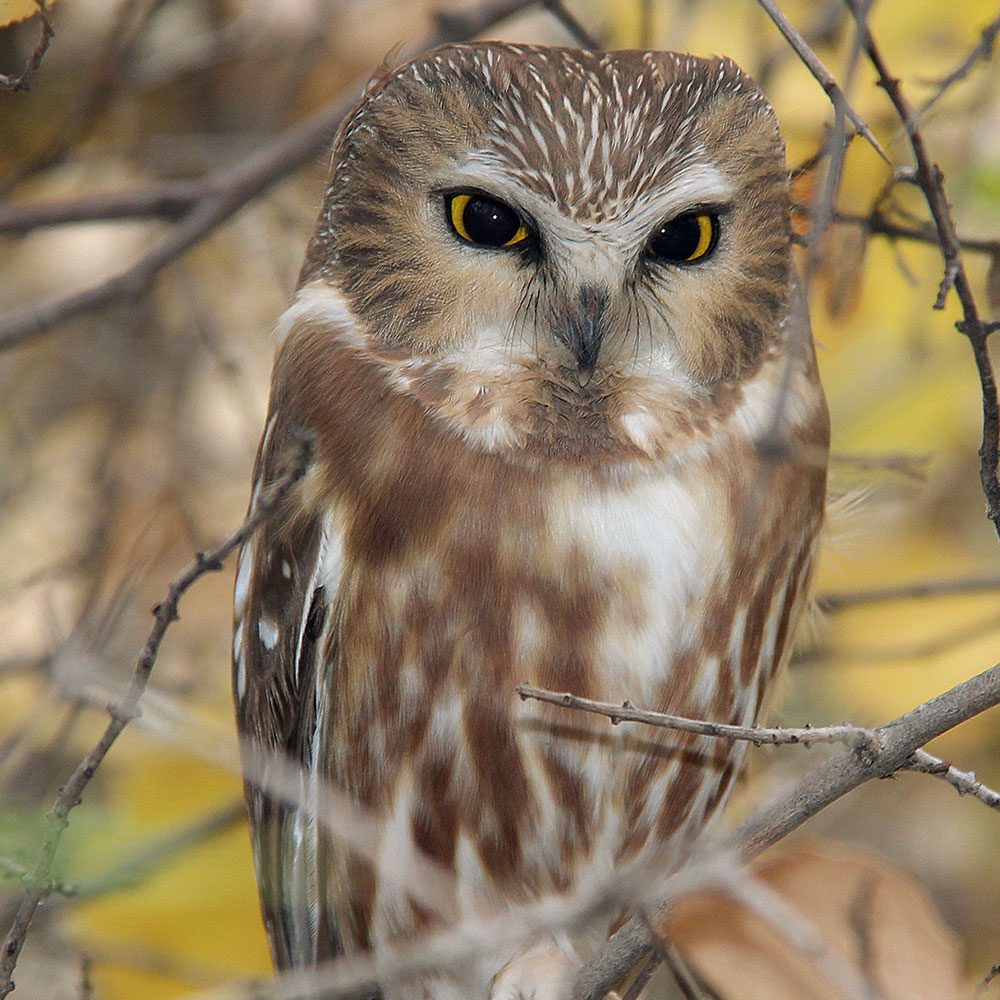
A Born Bird-Lover
I don’t remember when or how my interest in birds began. If I were to guess, I would have to say that it began when photography became a very important part of my life. The variety of colours, sizes and habits of birds intrigued me and with the ability to capture them through a lens, my enjoyment of them increased.
This interest in birds was something that I shared with my late father. Long before I caught the “bird bug,” he was feeding them in his beautiful yard in Milk River, Alberta. My dad was old-school, a man who worked hard all his life, and I was surprised that bird watching would become one of his favourite things to do. My mom did not share the same enjoyment in watching birds as Dad. He liked to feed them fairly close to their deck and because of birds doing what birds do, it often became an annoyance to Mom to have to clean the deck as much as she did.
It must have been a small inconvenience for Mom though, as they would go on to share 67 years of marriage together. Before they both passed on, I was able to show them many photos of birds that I had taken.
I like all birds, but I do admit that I am partial to owls. In particular the snowy owl. To me they take the sting out of a cold winter day but more importantly, when I see one I believe that my dad is thinking about me. The tiny hummingbird would be right up there as well, as this bird makes me think of my mom.
It is more than just capturing the various types of birds with a camera that I enjoy—it’s also the challenge of trying to identify the kinds of birds I see before me. Many are easy to name, but birds that make only a short visit to your yard as they migrate back and forth during the spring and fall are the ones that make you break out your bird book to try to put a name to them—and that simply adds to the enjoyment.
The number of feeders I have in my yard seems to increase every year. My wife casts a wary eye at me every time she sees me holding up a feeder in a store. In the winter, my bird diner is not as buys as it is during the summer, but there are still regulars who come every day.
Of course the birds love the feeders, but so do I, as they allow me the opportunity to take photos of my feathered visitors. Birds are like people—not all of them enjoy city life, so there are times when I pay them a visit out in the country.
It would be interesting to know what the average age of a birder is. I would have to believe that the vast majority are baby boomers, and are people who find pleasure in the simpler things in life. I am pretty sure that my two grandsons would not be all that pumped if their grandfather suggested going on a bird-watching adventure with them.
For now, I am content with the return of my seasonal visitors. I keep my camera ready and my vehicle full of gas as I continue to learn more about the world of birds. —Jim Stickel
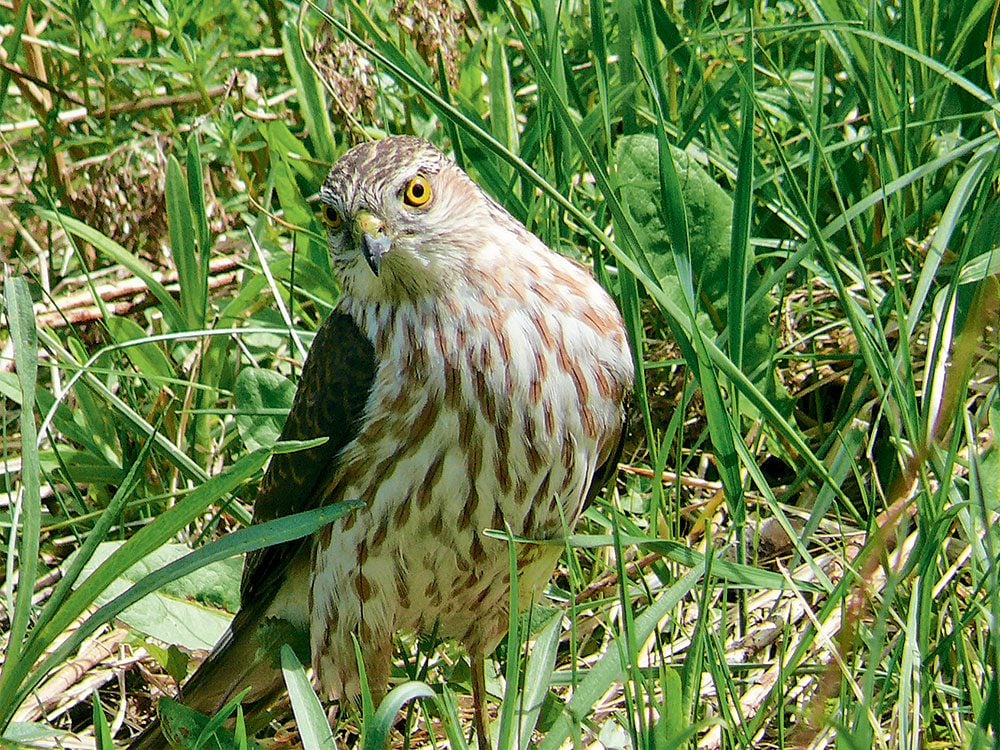
Duel on the Grand River
Several years ago, I was out for a walk with my trusty camera. I was walking along a beautiful nature trail on the Grand River here in Kitchener, Ontario. You just never know when you’ll come across that perfect photo op. Today was going to be one of those days for me. Approaching the far end of the trail, near the area I usually turn around to go back, I spotted movement and commotion in some scrub about 12 feet away from me. I was amazed to see a Cooper’s hawk perched on the ground, totally oblivious to my presence. Up went my camera and I zoomed in on it. I kept snapping as I slowly moved around to achieve the best vantage point. I could not figure out why this hawk was on the ground and totally ignoring me. Normally they would be gone by now. I was in Heaven as I normally don’t get that close to such a magnificent creature. I took one more step to my right and a foot closer to this wonderful bird when, suddenly, up flew a small song bird from some undergrowth. It happened so fast I couldn’t even identify the small bird. Up into the sky went the Cooper’s hawk, right on the smaller bird’s tail. They both flew around a corner behind some trees and disappeared—the hunt was on.
I don’t know what the final outcome was for either bird, but I certainly am happy I was there to photograph the experience. The moral is, always keep your camera ready as you never know when that perfect picture will come your way. —Michael G. Henderson
Read the incredible story of how a family raised a baby Canada goose for a year—then, 20 years later, it returned.
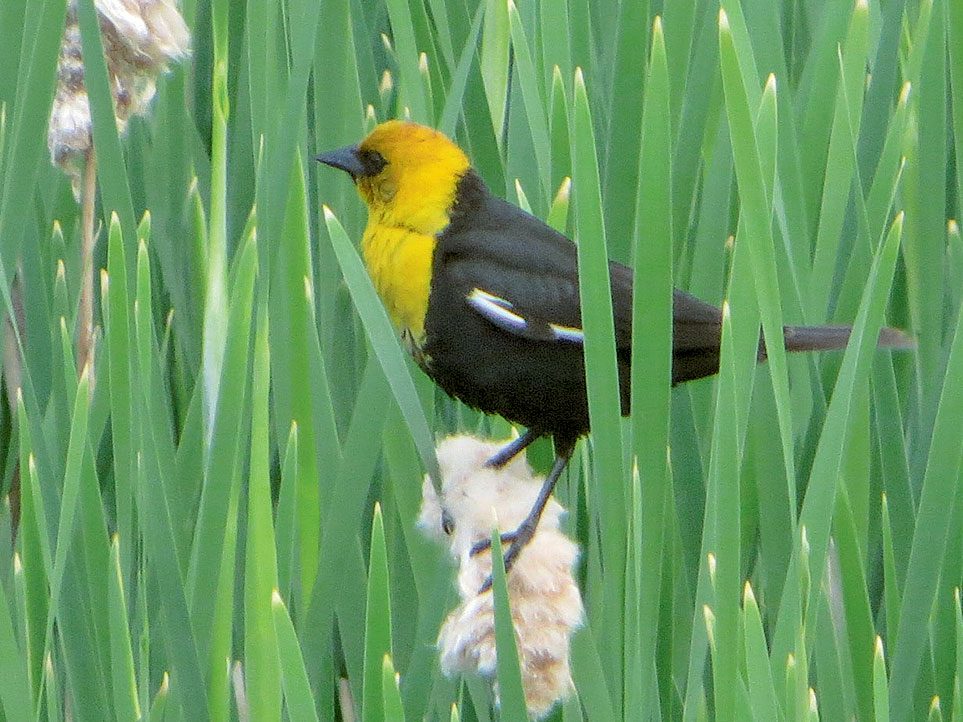
Counting 100 Species of Birds in 100 Mile House, B.C.
It’s a late May afternoon and the day has grown progressively hotter. I’ve been birding since 5 a.m. and although I was full of enthusiasm and concentration during the cool morning hours, the heat of the day has made me a bit weary. My goal at the outset of the day was to count 100 species of birds in close proximity to the town of 100 Mile House, British Columbia, and I’m very close.
As I often do, I began my bird search at the 100 Mile House Marsh, a small wetland area in town, where it is possible to see over a dozen species of ducks, trumpeter and tundra swans, and several species of grebes. The marsh is also home to the ubiquitous yellow-headed blackbird. If you are really lucky you might also see all six species of swallows on the power line near the arena.
From town, I head west to the Bridge Creek area to look for birds such as the solitary sandpiper, hooded merganser olive-sided flycatcher and the American three-toed woodpecker. To the south at 83 Mile’s Bogie Summit, the elusive Townsend’s solitaire cavorts on the volcanic bluffs. The golden-crowned kinglet can be heard singing from the treetops on the way to the lookout. And on it goes as I scour out all the bird species within a 12-mile radius from the centre of town.
As the afternoon warms up further, I slump into the welcome shade of a lone poplar tree on the sloping pastures above Exeter Lake. My list sits at 93.
But my relaxed attitude has a focus even as I take this little breather. I know that both species of rail—the sora and Virginia—birds still missing from my list haunt the riparian area of this lake and, being that they are furtive in their manner, listening for their voices is the best way to find them.
As I wait for the rails to call, I set up my scope on its short legs and scan the lake and surrounding area for other bird species. I spot a lone surf scoter far out on the water as six ring-billed gulls drift lazily past. Two brown humps, with just their backs showing in the tall grass, turn out to be a pair of sandhill cranes. A Northern harrier flies up from the extensive sedge meadow on the east end of the lake and escorts a passing bald eagle away from the area—a sign that the harrier likely has a nest in the vicinity. These are all birds I need and my list continues to grow.
Then, over the strident call of a disturbed killdeer, I hear one of the rails, “Ikit-ikit-iki.” It’s the unmistakable call of a Virginia rail. A short time later I hear a far-off whinny. It’s not a horse come to claim its pasture, but the sound of a sora rail. The number of birds on my list now sits at 98.
Satisfied with the results here at the lake, I make my way homeward, confident that I can add the last two species at the house. As the day starts to cool, I will hear the song of the hermit thrush from my back step. And the rufous hummingbird that has eluded me all day will visit my feeder before dark.
I’ve done it again. I’ve counted 100 species of birds in one day in close proximity to the town of 100 Mile House.
When I moved here more than 20 years ago, I kept notes on the bird activity around the area, noting everything from the arrival dates of migrants to the nesting times of the various species. Eventually, I realized that an impressive number of bird species could be found during a one-month period, from the middle of May to the middle of June. The goal of 100 species in a day is simply my way of taking a core sample of the richness of the bird life in the area. I have never failed to get within two or three species of reaching that arbitrary number, and oftentimes I have surpassed the goal by a few birds. But regardless the outcome of my quest, I am spending time outdoors in a most impressive part of Canada, the beautiful South Cariboo region of British Columbia. —Tom Godin
Looking for feathered friends in the Big Smoke? These are Toronto’s best spots for bird watching.

Proud and Free
Barbara Elisabeth Tiedke of Vancouver writes, “I love this photo as I believe it is such a powerful images that symbolizes a feeling of being wild and free. For me, the eagle represents the vastness of Canada’s wilderness really well. I also like the cultural connection between the eagle and the First Nations People of Canada: ‘The eagle has the ability to live in the realm of the spirit, and yet remain connected and balanced within the realm of the Earth.’ I snapped this picture at Spanish Banks, a series of beaches here in Vancouver.”
Don’t miss these see-worthy sights along the Vancouver seawall.
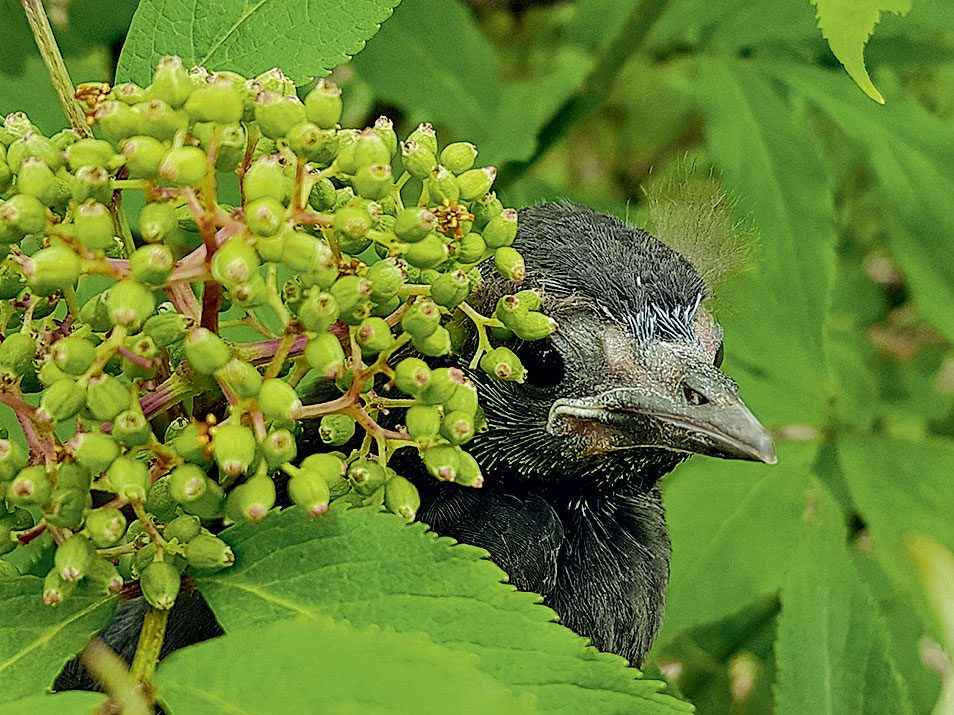
Fly Away Home
Shelly Pals of Castor, Alberta, writes: “We were busy redoing some flower beds last spring when my husband pointed out this baby bird hidden in the trees. I think it had just taken its first solo flight—it still had some fluffy tufts on its head. Still not quite sure of its flying abilities, it stayed there for a while. We continued working, making sure our cat did not get too close, so that the bird could gain confidence before it moved on. Several hours later, we checked back and it was nowhere to be seen. We hope it’s now one of the birds we see flying around our yard!”
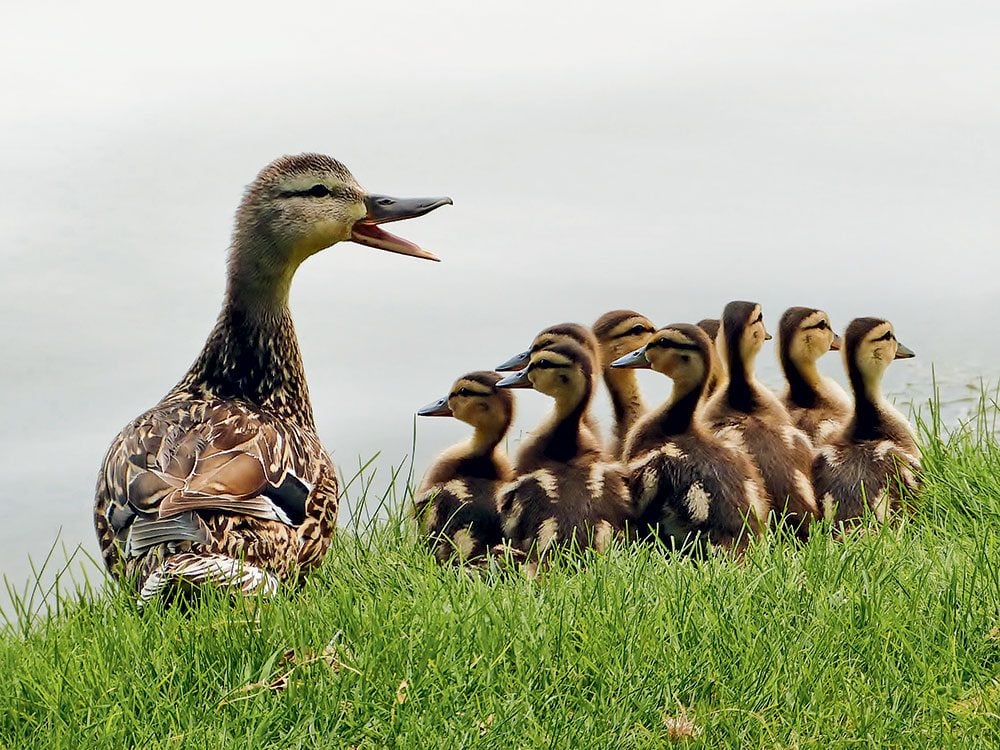
Duck, Duck, Goose!
Nestled in the heart of my hometown of Portage la Prairie, Manitoba, and flanking our beautiful Island Park, is an often-overlooked wetland known as Crescent Lake. This little oxbow lake attracts a variety of waterfowl species such as pelicans, plovers, grebes, plus the occasional swan. However, it is the colourful mallard ducks and the oodles of Canada geese which descend on the water every year that provide me with a ready source of wild birds to photograph.
The ducks and geese are indeed most photogenic when they sport their breeding plumage and, of course, when they have recently been hatched. Due to our very short Manitoban springs and summer, however, there is only a small window of opportunity to take pictures of the fluffy chicks before they grow out their adult feathers. Nonetheless, I find that these birds’ adorable and comical poses beg to be captured at every stage of their humble duck and goose lives.
I make it my goal to take photos at Crescent Lake at least one day a week during the peak seasons. My photographic adventures begin in the spring when the ducks first arrive to nest in the cattails. I finish shooting in late fall when the last goose has flown to warmer climes for the winter.
Patience and quietude are a must when photographing wild birds. I prefer to keep a healthy distance from these beautiful—but very wild—creatures. Nursing a bruise on your posterior from a defensive father goose is not anyone’s idea of a noble war wound, so I consider myself very fortunate to own a good camera with a built-in digital zoom. My type of camera may be considered obsolete technology by now, but it suits my needs just fine.
If you happen to stop into Portage la Prairie during your travels, please make an effort to visit our lovely Crescent Lake. You just may see a tiny woman aiming her camera towards the many wild ducks and geese congregated on the shore. And, yes, that camera lady would probably be me. —Debbie Reichelt
This is what it’s like photographic blue jays from your back yard in winter.
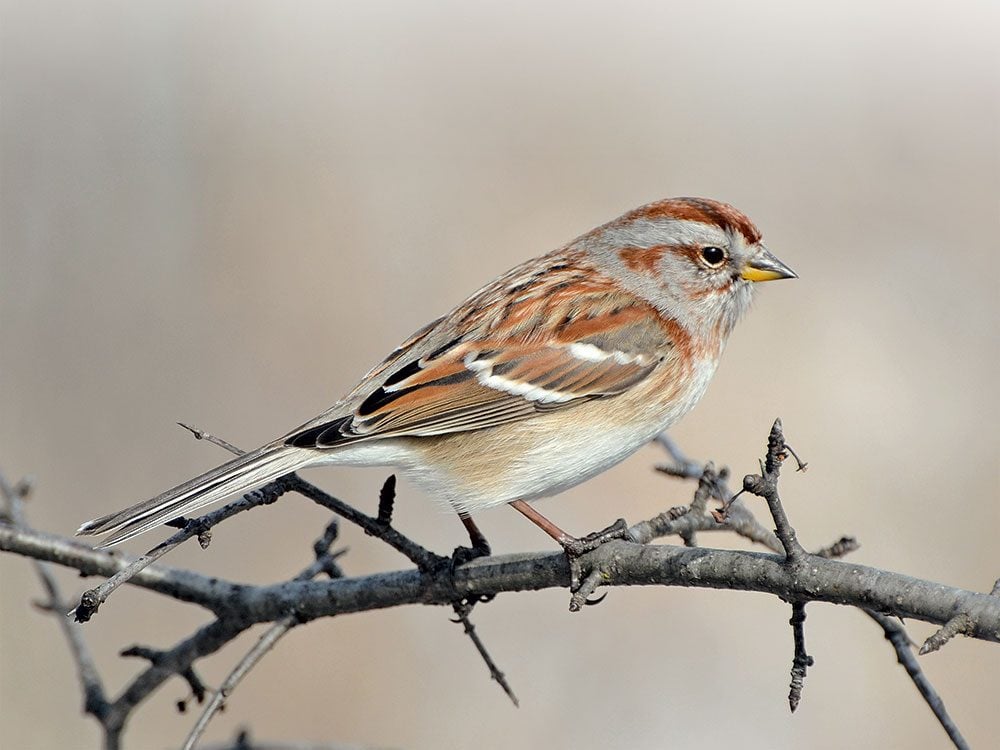
Watch the Birdie
I have had cystic fibrosis my entire life. When it caught up to me as an adult, my working career was cut short. Retired at 49, I began looking for a hobby to fill the void. I was introduced to photography by my brother, Mark. I find it very enjoyable, easy to do and it gets me out in nature. With the peace and quiet, I am able to relax and just watch the birds come and go as they put on a show. I find it amazing how fast they move. Hummingbirds in particular are so small, yet so strong. —Frank Roden
Don’t miss this gorgeous gallery devoted to the mountain bluebird.
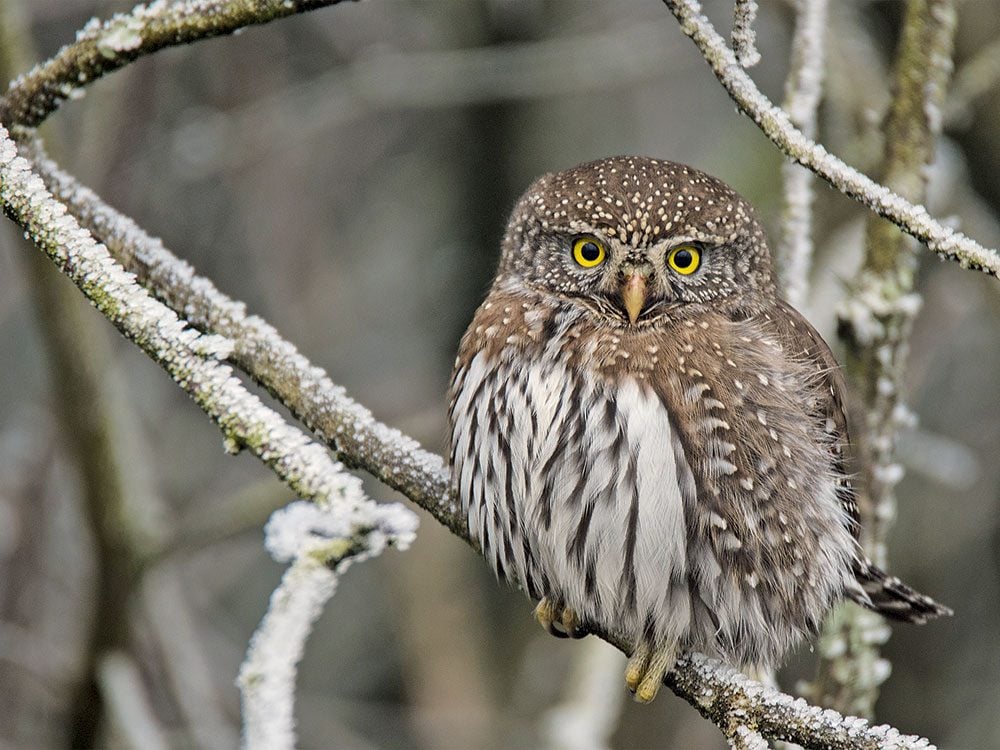
Tiny But Fierce
It was a frosty winter day when I went out for a hike in nearby North Vancouver with my wife Michelle and sister-in-law Shannon. The fog was really thick and we were questioning whether we should go for coffee instead of walking around outside in the cold.
When we hike, we usually look for birds and wildlife, but with the thick fog the odds of spotting any birds weren’t great.
The three of us were chatting as we hiked the trail, when Shannon pointed up to a tree branch and whispered, “Pygmy owl!” She was trying to be quiet so as not to scare him off, but she loves owls and was very excited.
I set up my tripod and began clicking away as we watched this tiny owl moving his head back and forth, looking for prey. At first it was tough to get photos through the fog, so we watched him for a bit then decided to continue on our hike.
A while later, as we were heading back, we were lucky enough to spot the same tiny owl close to where we’d first located him. He was actively hunting voles and songbirds, his head constantly turning as he searched for his next target.
Although pygmy owls only measure 16 to 18 centimetres in length and weigh between 60 and 70 grams, they can take down prey three times their own size—they’re fierce hunters. On the backs of their heads they have “false eyes,” a feather pattern that resembles eyes to scare off predators. They’re diurnal owls, which means they are active during the day.
We were lucky to find this little owl and had fun watching him. I managed to capture this show after the fog had lifted slightly. —Tony Joyce
Find out what it’s like photographing birds in the dead of winter.
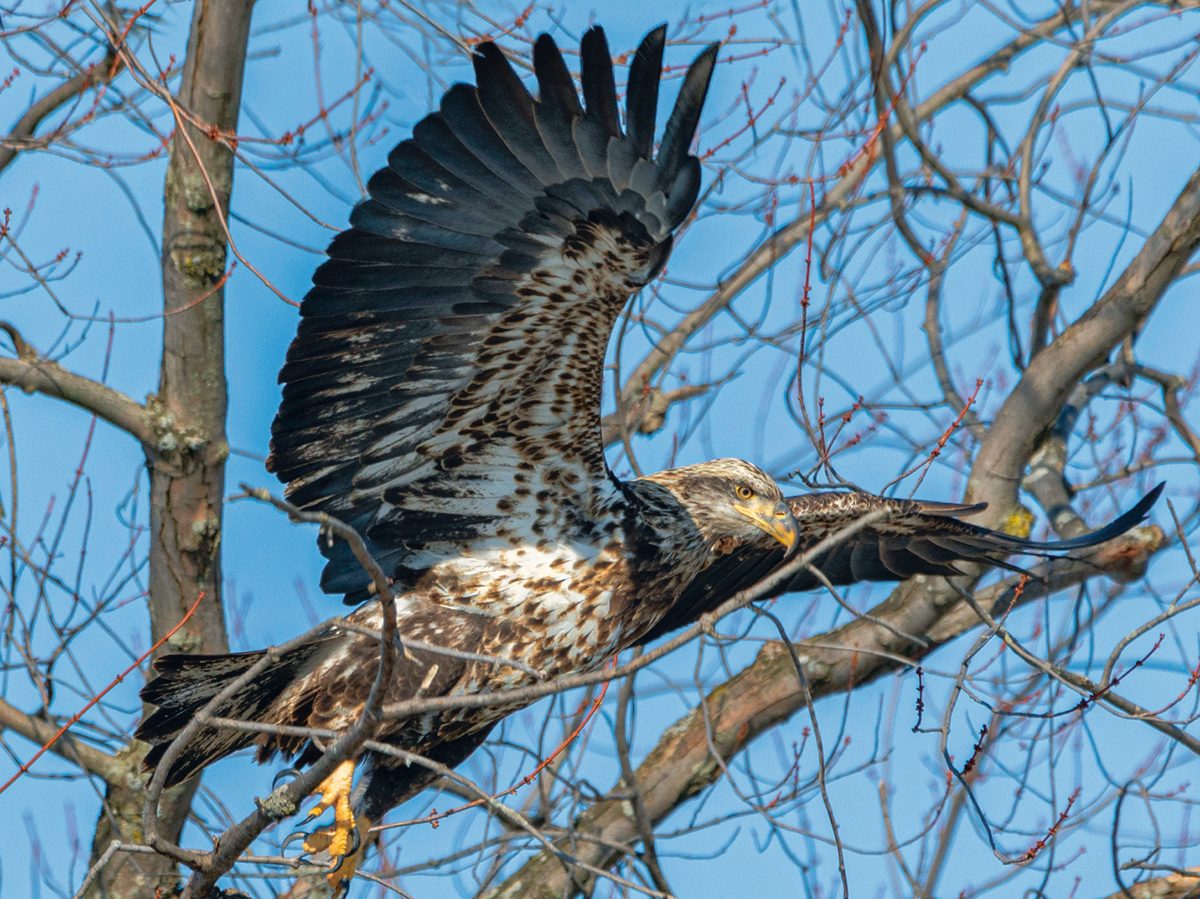
The Return of the Eagles
I am so lucky to live along the shores of Lake Erie. As I travel around, it is not unusual to see one of these beautiful bald eagles out fishing or perched in a tree looking for its next meal. With the banning of the harmful substances that were killing them off—40 years ago they were on the endangered species list—they are making a comeback and their numbers are increasing all the time.
We have a couple of young juveniles that like to hang out at the local pond on our road, and I never get tired of watching them. The area neighbours know it’s me parked alongside the pond to snap photos and watch the eagles fish. When the lake freezes in winter, you can often catch a glimpse of them fishing, in early morning and late afternoon, in some of the man-made areas where the water runs all year. I have spent many days outside freezing my fingers off waiting for the perfect shot and when I get one, it is such a thrill. Last year, an adult male and female would hunt together not far from my home so I’d take daily trips to try and get a picture of them. It was so great to hear them calling to each other and to watch their interactions.
When the trees are bare, you can sometimes catch a glimpse of an eagle’s nest. They are massive and usually built pretty far away from humans, which is a good thing unless you are trying to observe them!
Bald eagles do not get their beautiful white plumage until around the age of five, but are still strikingly beautiful in their immature plumage as well. It’s amazing to see the difference.
So keep your eyes on the skies and you just might see one of the ever-increasing population of beautiful bald eagles. – Christine White
Check out more great Canadian bird photography.